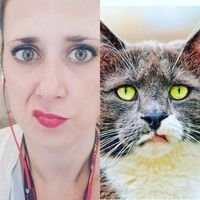Search the Community
Showing results for '3 week stall'.
Found 17,501 results
-


Low blood pressure and heart rate
Lisa Collom replied to crazycatlady8's topic in POST-Operation Weight Loss Surgery Q&A
Not only did I experience this, I passed out twice in one day. The second time I nearly drowned. The first time I broke my foot, sprained my back and sprained both knees. I'm still on crutches. I'm drinking more Water, using more salt and taking midodrine to keep my blood pressure steady. Please don't wait to get hurt like I did. Talk to your doc ASAP about coming up with a treatment plan. I had warning signs for weeks (and I've had very low blood pressure my entire life) and I got hurt badly because I ignored them. -


Is it normal to be sooo tired after surgery?
Bethanyblondie replied to LindaD's topic in POST-Operation Weight Loss Surgery Q&A
I had surgery on the 18th of May and went back to work on the 21st...I got up that morning and showered and I literally had to sit for 10-15 minutes just to get my energy back to blow dry my hair afterwards! Then just driving to work I was miserably tired. I came home that afternoon and slept for like, four hours. I think it's pretty normal to be completely exhausted for up to a good week or so after surgery. Your body isn't working great when all you've had for days is clear liquids! I had the same issue where I couldn't even see words clearly because I was so tired! -


Is it normal to be sooo tired after surgery?
Sarah.R replied to LindaD's topic in POST-Operation Weight Loss Surgery Q&A
I was tired until about day 3 then I was fine, then I started on mushies on the 26th and my energy has gone was down again. It's obviously because we're not getting enough nutrients and stuff. The latest I've been able to stay up is 11pm and even when I did stay up then before being banded I just went to bed cuz there was nothing to do, now it's out of exhaustion. Eventually it'll get better, I hear some people still don't feel fantastic up until the 3 month mark but hopefully that won't happen. -


Something to remember about failing.
Deleted Account 2 posted a topic in POST-Operation Weight Loss Surgery Q&A
So I forgot to put this last week. I was reading some article in People magazine that was about that country singer that's married to Garth Brooks. I know her because of her cooking show on food Network: Trisha Yearwood. She's lost about 30 pounds and I figured this would be the same old kind of article about eating right and exercise that we always see. It wasn't. She was so honest about living her life at size 16 for decades and just wanting to be able to be less tired. The thing I thought was so cool about this piece was when she said a couple of weeks ago after some awards thing her and Garth were flying back and she ate an In N Out burger with fries and a coke and she had two Peanut Butter cups. Usually she'd just go "Well, my diet is ruined so I might as well just keep eating everything I want to eat" but now she thinks "Ok. I splurged. No big deal." and the next day she ate like she was supposed to and went to Zumba class and that was that. And she didn't have any weight gain and realized this is how normal people eat. Normal people do not beat themselves up everytime they have a burger. Normal people do not constantly think about food or the ramifications of having a piece of chocolate. As long as your indulgences are limited to splurges and not an everyday occurence, we should stop being so obsessive and negative towards ourselves. I really found this helpful. I am just like that. I'll eat chips and think "Well, since I've already come this far" when really I just need to go "Those were a great treat. Where's my Water?" instead. Alright. That's all. Just felt like sharing. Ters -
I was banded last week. So far the liquid diet was a little tough mentally but fine physically. I have lost 15 pounds in a week (WHICH i KNOW WILL SLOW BUT I AM STILL THRILLED SO FAR.) My problem is that while doing clear liquids I was with my family away from my home of NYC. Now that I just got back today I am struck by how much food there is out there. How many amazing restaurants etc. I am fine except for sushi. I LOOOVE sushi. One major concern is that when I can have regular food again they say rice may be difficult to digest. Can someone tell me if they are able to eat sushi rolls anymore? Diet coke I could give up, but living without spicy tuna might be heartbreaking for me...
-
Oh no, I love sushi! I'm going back to NY two weeks after my surgery to visit friends, and I'm worried. This is really good to know, thanks!
-
Went this afternoon to have the drain removed. Down 8 pounds since surgery on 11/14. Start puréed stage Tuesday and go back in 3 weeks. Now for this soreness to go away I'll be a happy camper!!! Sent from my iPhone using the BariatricPal App
-
I was told 2 weeks.
-
Hi all, Looking for a little advice. I have NOT been 100% on my pre-op diet.. I feel as though I have failed at it & I'm having surgery in 2-3 days time.. Should I tell my surgeon and have it postponed or have other people on here been in the same situation as I am in currently? I feel terrible
-
Hey, I’m Joey I’m from New Jersey. I’m probably one of the youngest people to be on this forums as I just turned 17 at the start of this month. I was 390 pounds at my highest, 375 pounds in the day of surgery (08/28/18) and am currently 345 lbs. at the moment I’m super worried because this morning I gained a pound for the first time. I do pretty heavy exercise 2 or 3 times a day and pretty much eat the way I’m supposed to with a very few modifications. If anything I’m eating less then I’m supposed to. Why did I gain a pound? Also how much 16.9 oz water bottles should I have a day and how long should it take me to finish one? Thank you!
-


feeling so much energy today :)
auntiegoo commented on Minnesotalady's blog entry in Minnesotalady's Journal
I know how you feel I have been working out at least 1 hour 5 times a week and have been feeling so good, today I just had this great feeling of happiness...so glad I decided to get banded!!!! -


Surgeons and hospitals in Louisiana
Bbinder2002 replied to Bbinder2002's topic in Weight Loss Surgeons & Hospitals
What is your pre op diet? Do you have to do 2 weeks of liquids? I wonder if this varies based on patient size. -


Why is there NOT "Sleeve" commericals like the "Bands"
mountain_lover replied to Brenda0600's topic in PRE-Operation Weight Loss Surgery Q&A
Here is a part of one of my postings on this forum in the insurance threads: the Duodenal Switch was being performed on patients, but if the patient had a very high BMI and health problems which made it more risky to have the Duodenal Switch, then doctors would perform the Sleeve (Which is the First part of the duodenal surgery and only restrictive), hoping that the patient would lose weight down to a SAFER, LOWER BMI, then the other part of the Duodenal surgery which is Malabsorptive could be performed without all the risks that were present before the Sleeve, so that the patient could lose more weight to reach their goal. ------------>>>>> What many doctors were discovering was that many patients continued to lose the weight and was reaching their goals with only the Sleeve, and the second part of the surgery did not need to be performed. So then many doctors started performing The SLEEVE as a STAND-ALONE RESTRICTIVE PROCEDURE. Now the sleeve is becoming a more sought after surgery by doctors and patients, because it is a less expensive, less evasive, and less risky surgery. Also the doctors know that there are less complications and healing time is faster with the Sleeve vs. the other procedures.--------------->>>>>>>> Medicaid and Medicare are now approving some Sleeve procedures. I hope this helps to explain the sleeve and how it came to be. Some insurance companies and doctors still consider it to be an experimental surgery. The procedure has been performed on many patients as the first part of the Dueodenal Switch for quite some time. Now it is a procedure that some doctors and some insurance companies are willing to have patients to consider having done instead of having the more evasive surgery. Maybe as time goes by and more understanding of this procedure takes place, then more insurance companies will cover it and more doctors will perform this procedure. Then we will possibly see more advertizing of this procedure. I live in Somerset Ky and my surgeon is Dr. Husted. He has a commercial on TV during the show "THE BIGGEST LOSER". He lets people know that he does different procedures. Some doctors only perform the Band and some do other ones. Dr. Husted created a new procedure called "THE VERGITO". It is a combination of 3 different procedures, using some of each to do one New Procedure The Vergito from what I understand it to be. Before I had the sleeve on Dec. 2, Medicaid here in Ky did not cover the sleeve until in November. Also the sleeve was done with 5 incisions laprascopically up until right before I had mine done, then Dr. Husted started doing the sleeve with only one 2 inch incision right above the belly button. I was his 2nd patient which he performed the one incision. The only pain I had was from gas pain after surgery, No pain at the one incision site. They are constantly learning more and more about bariatric surgery and different procedures. I hope I have helped you to understand a little more about the sleeve. I wish you all the best and a happy journey. -


Laparoscopic Greater Curvature Plication: An Alternative Restrictive Bariatric Procedure
Alex Brecher posted a topic in Gastric Plication Surgery Forum
Abstract Vertical sleeve gastrectomy is a restrictive surgical technique that involves resection of a significant portion of the stomach by means of stapling the greater curvature. This procedure is rapidly gaining popularity and acceptance as a primary bariatric procedure with good results on weight loss. The other restrictive bariatric procedure is the adjustable gastric band. As the results on the vertical sleeve gastrectomy and the adjustable gastric band vary, there is still a gap that can be fulfilled by another procedure. The authors present an alternative procedure that is under investigation that can be as restrictive as sleeve gastrectomy with no staple line or prostheses. This procedure is called laparoscopic greater curvature plication, which is similar to vertical gastric banding, but without the need for gastric resection. The stomach is reduced by dissecting the greater omentum and short gastric vessels, as in vertical sleeve gastrectomy, then the greater curvature is invaginated using multiple rows of nonabsorbable suture over bougie to ensure a patent lumen. This article includes the background, method, initial results, and a brief discussion on this new procedure. Introduction Traditionally, the primary mechanisms through which bariatric surgery achieves its outcomes are believed to be the mechanical restriction of food intake, reduction in the absorption of ingested foods, or a combination of both.[1,2] Adjustable gastric banding (AGB) and vertical sleeve gastrectomy (VSG) are restrictive approaches commonly used in bariatric practice.[5,6] Although these procedures have proven to be good therapeutic options for some patients, they are not without significant complications, such as erosion or slippage of the gastric band or gastric leaks in VSG.[3,4,7,13,14] Leaks in VSG pose a particularly difficult challenge when they occur near the angle of His, potentially generating severe clinical conditions that require reoperation and may even cause death.[4] Since 2006, the authors have been evaluating the safety and initial results of the laparoscopic greater curvature plication (LGCP™), a restrictive bariatric surgical technique that has the potential to eliminate the complications associated with AGB and VSG by creating restriction without the use of an implant and without gastric resection and staple. Methods Using the National Institute of Health’s (NIH) inclusion criteria for bariatric surgery (patients with a body mass imdex >40kg/m[2] or BMI over 35kg/m[2] with at least one comorbidity), all patients underwent a multidisciplinary evaluation (endocrinologist, cardiologist, psychologist, and nutritionist), blood tests, abdominal ultrasonography, and upper endoscopy to establish baseline. The study design was a prospective, noncomparative case series that received approval from the local ethics committee with patients signing informed consent. From January 2007 to March 2010, 62 patients (44 female) were submitted to LGCP. Mean age was 33.5 years (ranging from 23 to 48 years) and mean BMI was 41kg/m2 (ranging from 35 to 46kg/m[2]). Technique Patients were placed under general anesthesia in supine positions. A Five-trocar port technique, similar to Nissen fundoplication, was used. Trocar placement was one 10mm trocar above and slightly to the right of the umbilicus for the 30-degree laparoscope; one 10mm trocar in the upper right quadrant (URQ); one 5mm trocar also in the URQ below the 10mm trocar at the axilary line; one 5mm trocar below the xiphoid appendices; and one 5mm trocar in the upper left quadrant (ULQ). The procedure began with angle of His dissection and removal of the fat pad, followed by careful dissection of the gastric greater curvature using the Harmonic™ scalpel (Ethicon Endo-Surgery, Inc., Cincinnati, Ohio), opening the greater omentum at the transition between the gastric antrum and gastric body. Once access to the posterior wall was achieved, the greater curvature vessels were dissected distally up to the pylorus and proximally up to the angle of His. Posterior gastric adhesions were also dissected to allow optimal freedom for creating a greater curvature flap. Gastric plication created by imbrication of the greater curvature over a 32-Fr bougie applying a first row of extramucosal interrupted stitches of 2-0 Ethibond™ (Ethicon, Inc. Somerville, New Jersey) sutures. This row guided two subsequent rows created with extramucosal running suture lines of 2-0 Prolene™ (Ethicon, Inc., Somerville, New Jersey). In the final aspect, the stomach was shaped like a sleeve gastrectomy but slightly larger. Leak tests were performed with methylene blue in all cases. No drains were left. Patients were discharged as soon as they accepted a liquid diet without vomiting. They also received a prescription of daily proton-pump inhibitor (PPI; single dose) for 60 days. Ondasentron and hyoscine (anti-spasmodic) were prescribed for seven days. The postoperative diet was a customized liquid diet for two weeks, with progressive return to solid foods in a stepwise fashion. Dietary restrictions were removed after 4 to 6 weeks, depending on patient adherence. Follow-up visits for the assessment of safety and weight loss were scheduled for 1 week and 1, 3, 6, 12, 18, and 24 months in the postoperative period. Endoscopic evaluations were scheduled for 1, 6, and 12 months postoperatively. Results All procedures were performed laparoscopically without conversions. Mean operative time was 55 minutes (40–110 minutes). Mean hospital stay was 36 hours (24 to 96 hours). On average, patients returned to normal activities seven days (4–13 days) following surgery. Mean percentage of excess weight loss (EWL) was calculated to be 20 percent at one month, 32 percent at three months, 48 percent at six months, 60 percent at 12 months, 62 percent at 18 months, and 61 percent at 24 months. No intraoperative complications were documented. All patients had lost at least 10 percent of total body weight. In the first postoperative week, however, nausea, vomiting, and sialorrhea in occurred in 22, 14, and 33 percent of patients, respectively. In all cases, these symptoms were resolved within two weeks. There has been no record of weight regain in any patient to date. Postoperative upper endoscopy and radiologic evaluation were performed on 12 patients at one and six months and in seven patients at up to 12 months. Qualitatively, the upper endoscopies suggest that the initial greater curvature fold is smaller at six months when compared with the initial fold size at one month, but appears unchanged at 12 months. Mild esophagitis (Grade A of Los Angeles classification) occurred in four patients at one month postoperatively; these patients were symptomatic (nausea, vomiting, and sialorrhea) and were kept on PPI, following the standard protocol. The six-month endoscopic evaluation identified no lesions or symptoms. Lumen size appeared stable (e.g., no dilation) based on upper gastrointestinal (GI) radiologic series performed on these patients at one and six months Discussion Reducing stomach capacity to promote mechanical restriction to food intake is one of the traditionally accepted mechanisms used in bariatric procedures to promote weight loss. There are at least two surgical procedures that appear to rely on this principle in current clinical practice, AGB and VSG. AGB achieves around 50 percent EWL, but unsatisfactory weight loss occurs in more than 20 percent of patients with failure rate requiring surgical revision in up to 25 percent of patients.[7] VSG as a primary bariatric procedure shows medium-term results to be adequate (>60% EWL), with improvements in comorbidities.[4,14] These promising results are associated with some complications, however, such as esophagites, stenosis, fistulas, and gastric leaks near the angle of His. These leaks and fistulas are reported in nearly one percent of cases and can be very difficult to treat.[4,14] LGCP is notably similar to a VSG in that it generates a gastric tube and eliminates the greater curvature, but does so without gastric resection. Initial clinical reports by Talebpour and Amoli[10] and Sales[11] demonstrate satisfactory weight loss up to three years. Brethauer et al12 reported increased weight loss in patients receiving LGCP when compared to plication of the anterior surface. The present series, compared to findings reported in some series involving AGB, has the lowest early complication rates among all bariatric procedures. Even with no major complications to report in the present series, Talebpour and Amoli[10] report one case of a gastric leak associated with a more aggressive version of LGCP, which they attributed to excessive vomiting in the early postoperative period. Adverse events described by patients were minor, lasting up to two weeks. These events may be related to the restriction induced by the invagination of the greater curvature and/or edema caused by venous stasis. Qualitative endoscopic findings suggest that the greater curvature fold gets smaller. This may be related with the resolution of the initial edema, although the radiological findings did not reveal significant dilation of the LGCP at six months. The percent EWL achieved a satisfactory 61 percent at 24 months in eight patients, with all patients achieving at least a 10-percent loss of initial weight. This can be favorably compared with results from VSG. This series is limited by the low number of patients, the simple study design, lack of a control group, the noninclusion of patients with BMI >50kg/m[2], and the incomplete follow-up period. This limits the broader acceptance of these results. These limitations limit the broader acceptance of these results. In order to better study this procedure, an international multicentric trial with centers in the United States, Chez Repuplic, and Brazil was designed (ClinicalTrials.gov Identifier NCT01077193). LGCP seems to be feasible, safe, and effective in the short term as a promising bariatric procedure on this initial series Acknowledgment Experimental evaluation was provided by Fusco et al8,9 that had published two articles about gastric plication on anterior wall and greater curvature of wistar rats achieving good results in weight loss analogy and significant better results of the greater curvature group. Recent clinical experience with variations of this technique has been described by few surgical groups. The authors’ initial experience was sent to the journal Obesity Surgery and was accepted for publication. More actualized data are described in this present paper. Original source can be fund here. -


Did anyone have MORE energy newly sleeved?
LipstickLady replied to liannatx's topic in POST-Operation Weight Loss Surgery Q&A
The three week mark was my turning point. My body was lighter, I was completely detoxed of chemical laden food, artificial colors, excess fatty mess... Plus the pure excitement of being post op and diet free!! -


Undecided on what to do
James Marusek replied to bigsexy28sc's topic in General Weight Loss Surgery Discussions
After many years of being overweight and then obese, health issues (diabetes, high blood pressure, sleep apnea, GERD) started to take hold of my body. It was like I was in a death spiral. I had RNY gastric bypass surgery 3 years ago and lost significant weight and that put all these health issues into remission. There are trade-offs in life. I traded my love of food for good health. I don't regret it. -


How much should we be losing each week?
Phillyphan posted a topic in POST-Operation Weight Loss Surgery Q&A
I know everyone is different, so the amount will vary. But on average, how much should we be losing a week? -


Sleeping on Stomach
GinaCampbell replied to nolady's topic in POST-Operation Weight Loss Surgery Q&A
Tummy sleeper for 50 years. Following my surgery, I slept on my back initially because I had a drain in. After a week or so I could lean more and more onto my side to sleep. Using pillows to support my stomach I slept that way for quite awhile. I can now sleep totally comfortably on my stomach as normal. That started around month 4 post op for me. Don't worry about this, you will get through it. Sent from my iPhone using the BariatricPal App -
For the first week post, i was eating clear liquids; drinking rather. I was allowed to progress to semisolid foods beginning the 2nd week post op. At that time my eating consisted of refrained beans, low fat string cheese, yogurt, egg whites, sugar free pudding, 1% cottage cheese and various protein fortified desserts. I have been cleared to progress past semisolid foods at my discretion and will try fish today for dinner. Mahi mahi is one of my favorites!
-
I've used miralax(actually used it today) and milk of magnesia. The milk of magnesia works alot faster but I didn't feel like I needed immediate relief so I used miralax. The milk of magnesia helped me out alot my 2nd week post op cause I hadn't had a bowel movement since before surgery and I felt like a new person afterwards lol.
-
From the album: Head Shots
-
I am! Just started it last week -- haven't used it as faithfully as I should, but am trying! I'm "MommaChaCha".
-


Red Bull and other energy drinks- "Lightly Carbonated"
PlzCoolerMe posted a topic in POST-Operation Weight Loss Surgery Q&A
Prior to being sleeved a month ago, I drank sugar free redbulls on a fairly regular basis (maybe two 8 ounce cans per week). However, I haven't had any since. This weekend was the first time that I really felt like I needed one, I had only gotten 4 hours of sleep and was really dragging. I looked at the can first, and it said "lightly carbonated." I got scared and tried a 5 hour energy instead... YUCK. My question: Is "lightly carbonated" going to be a big deal if you only drink a little? I've read other folks who've been sleeved saying that they are still able to drink small amounts of pop, beer, etc. I would think all of these have much more carbonation than Red Bull. Has anyone else tried energy drinks, and if so, how long after surgery? Thanks. -


Surgeons and hospitals in Louisiana
Bbinder2002 replied to Bbinder2002's topic in Weight Loss Surgeons & Hospitals
Yea Dr. Lavin told me just 1 day of liquids. I signed the consent last week so now just waiting for the scheduler to contact me. -


How much should we be losing each week?
Teachamy replied to Phillyphan's topic in POST-Operation Weight Loss Surgery Q&A
If you are far away from your goal weight, chances are you have more to lose and may lose more than 1-2 pounds per week, but that's a good estimate. I lost 15 pounds my first 2 weeks, 3 pounds the second 2 weeks. Last week it was 2 pounds. I find it better if I don't weigh everyday. The little up and down fluctuations would make me crazy!












